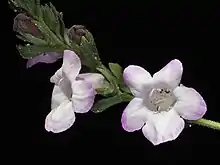| Dasymalla teckiana | |
|---|---|
 | |
| In the Australian National Botanic Gardens | |
| Scientific classification | |
| Kingdom: | Plantae |
| Clade: | Tracheophytes |
| Clade: | Angiosperms |
| Clade: | Eudicots |
| Clade: | Asterids |
| Order: | Lamiales |
| Family: | Lamiaceae |
| Genus: | Dasymalla |
| Species: | D. teckiana |
| Binomial name | |
| Dasymalla teckiana | |
| Synonyms | |
Dasymalla teckiana is a flowering plant in the mint family Lamiaceae and is endemic to Western Australia. It is a small, openly branched, sticky shrub with mauve and white, bugle-shaped flowers.
Description
Dasymalla teckiana is an openly branched shrub which grows to a height of 0.3–0.9 m (1–3 ft) and which is sticky due to the glandular hairs which cover its branches. Its leaves are stalkless, have their base partly wrapped around the stem, oval to egg-shaped, 0.8–2.5 cm (0.3–1 in) long and 5–10 mm (0.2–0.4 in) wide. They are sticky, glabrous and green with a few blunt teeth along their edges near the ends.[2]
The flowers are white and mauve, purple, lilac or violet and are usually arranged singly in upper leaf axils on a stalk 1–3 mm (0.04–0.1 in) long and covered with glandular hairs. The flowers are surrounded by green, leafy, oblong bracts, 4–12 mm (0.2–0.5 in) long and green, hairy, glandular bracteoles 2.5–5 mm (0.1–0.2 in) long. The five sepals are 5–8 mm (0.2–0.3 in) long and sticky with linear lobes and joined to form a short tube near their bases. The five petals are joined to form a tube 6–8 mm (0.2–0.3 in) long with a few hairs on the outside and glabrous inside except for a densely hairy ring around the ovary. There are five lobes on the end of the petal tube, the lower one elliptic to almost round and slightly larger than the other four lobes.[2][3]
Taxonomy and naming
This species was first formally described in 1889 by Ferdinand von Mueller who gave it the name Chloanthes teckiana and published the description in the Victorian Naturalist. The type specimen was collected by John Forrest.[4][5] In 1904, Georg August Pritzel changed the name to Pityrodia teckiana[6] and in 2011, Barry Conn, Murray Henwood and Nicola Streiber changed it to Dasymalla teckiana.[1][7] The specific epithet (teckiana) honours Francis, Duke of Teck.[5]
Distribution
Dasymalla teckiana occurs in the south-west of Western Australia, mostly north of the Great Eastern Highway, as far east as Kalgoorlie[2] in the Avon Wheatbelt, Coolgardie, Dampierland and Swan Coastal Plain biogeographic regions growing in a range of soils near granite outcrops.[8][9]
Conservation
Dasymalla teckiana is classified as "not threatened" by the Government of Western Australia Department of Parks and Wildlife[8]
References
- 1 2 "Dasymalla teckiana". APNI. Retrieved 4 December 2016.
- 1 2 3 Munir, Ahmad Abid (1979). "A taxonomic revision of the genus Pityrodia (Chloanthaceae)". Journal of the Adelaide Botanic Garden. 2 (1): 60–63.
- ↑ Daly, Barbara. "In flower this week (6 January 2012)". Australian National Botanic Gardens. Retrieved 5 December 2016.
- ↑ "Chloanthes teckiana". APNI. Retrieved 4 December 2016.
- 1 2 von Mueller, Ferdinand (1899). "Description on a new species of Chloanthes from Western Australia". The Victorian Naturalist. 6 (6): 104. Retrieved 5 December 2016.
- ↑ "Pityrodia teckiana". APNI. Retrieved 4 December 2016.
- ↑ Conn, Barry J.; Henwood, Murray J.; Streiber, Nicola (2011). "Synopsis of the tribe Chloantheae and new nomenclatural combinations in Pityrodia s.lat. (Lamiaceae)". Australian Systematic Botany. 24 (1): 6. doi:10.1071/SB10039.
- 1 2 "Dasymalla teckiana". FloraBase. Western Australian Government Department of Biodiversity, Conservation and Attractions.
- ↑ Paczkowska, Grazyna; Chapman, Alex R. (2000). The Western Australian flora : a descriptive catalogue. Perth: Wildflower Society of Western Australia. p. 214. ISBN 978-0646402437.